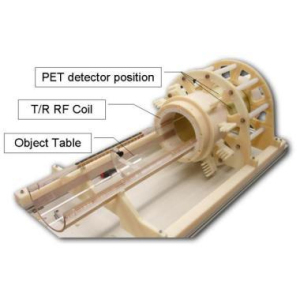por
Brendon Nafziger, DOTmed News Associate Editor | November 20, 2009

Prototype of the
preclinical PET-MR
(courtesy of Philips)
Scientists across Europe have gotten one step closer to the dream of many imaging specialists: a clinical PET-MR machine.
Thanks to a European grant for the HYPERImage project, a consortium of scientists across Europe have worked with Philips to develop a proof-of-concept, pre-clinical combined MR-PET scanner that could one day lead to improved radiation therapy and cardiology treatments.
HYPERImage, funded by the European Union, leading research universities and Philips, has a budget of around 7 million euros to advance medical imaging.



Ad Statistics
Times Displayed: 14289
Times Visited: 25 Final days to save an extra 10% on Imaging, Ultrasound, and Biomed parts web prices.* Unlimited use now through September 30 with code AANIV10 (*certain restrictions apply)
While not functional yet, the experimental PET-MRI device does suggest that the technology in development works, and that the team has overcome some of the most important technical hurdles in combining two normally mutually hostile systems: state-of-the art time-of-flight PET with a powerful 3 Tesla MR magnet.
"They are two great technologies, but in principle they are very allergic to each other," Steve Klink, a spokesman for Philips, tells DOTmed News.
What the scientists did was create PET detectors "compatible with the strong magnetic fields associated with MR," he says, while also developing methods for PET attenuation correction, where scattering of gamma rays can create inaccurate readings.
This is hard for a number of reasons. First, magnetic fields can play havoc with PET's sensitive detectors.
"Magnetics distort electronics," Tobias Schaeffter, Ph.D., a professor of imaging sciences at King's College London who worked on the project and whose colleagues have been researching PET-MR devices for the last ten years, tells DOTmed News. This means common vacuum-based photomultiplier tubes, at the core of a PET machine, would be impossible to use, as they would get scrambled. That's why for the device, the scientists installed silicon photomultipliers with integrated digital read-out electronics, which are impervious to the magnetics.
But the interferences run both ways: the PET's electronics could also affect the MR device, creating misleading images.
"Any kind of electronics you put in an MR system could distort the static magnet field, and also introduce radio frequency artifacts, because it's very sensitive to any kind of signals coming from television and mobile stations, for instance," he says.
To solve this problem, they housed the digital PET modules inside a tiny Faraday cage, which traps the potentially distorting RF waves.
"There is some interference for which we have developed a mathematical model. We went through a number of iterations to have this model done and to use for the PET-MR design to minimize the interference," Schaeffter says.

